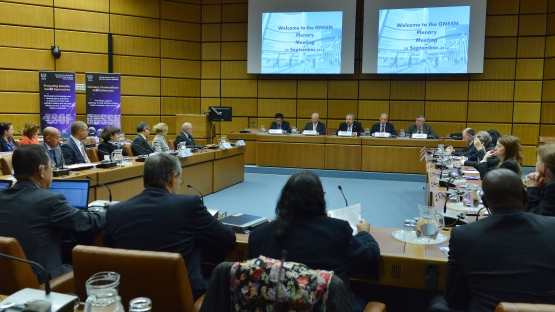Networking is an extremely important mechanism for IAEA Member States to share knowledge, experience and good practices in nuclear safety and security.
This point was emphasized by IAEA Director General Yukiya Amano in his address to the plenary meeting of the Global Nuclear Safety and Security Network (GNSSN) held at the IAEA headquarters on 24 September 2014.
Over 100 participants from Member States and participating networks attended the event, which was organized on the sidelines of the 58th IAEA General Conference.
"The Network is a platform for the sharing of information among experts in order to achieve a higher level of safety and security at nuclear facilities around the world. It is instrumental in spreading best practices and ensuring continuous improvement in nuclear safety," Director General Amano told the gathered diplomats and experts.
He noted that the IAEA's goal is to help Member States to achieve a high level of nuclear safety and security and assist them in developing the necessary infrastructure.
As far as nuclear security is concerned, Director General Amano said: "World leaders have recognised the need to prevent nuclear and other radioactive materials from being misused by terrorists or other criminals." Though nuclear security is primarily a national responsibility, he said a coordinated international response to the threat was essential. "The IAEA plays the central role in helping countries to ensure that nuclear and other radioactive materials do not fall into the wrong hands," he added.
Director General Amano emphasized the valuable contribution of GNSSN to both nuclear safety and security.
The half-day event introduced the Global Nuclear Safety and Security Network (GNSSN), and presented the activities and main achievements of the regional networks in 2013-2014. The Plenary meeting also provided information on the activities of the global topical networks as well as the new topics developed in 2013-2014, the development of the International Regulatory Network and the Technical and Scientific Support Organization Forum.
Presentations from IAEA experts touched on the IAEA strategic approach on GNSSN, nuclear security collaborative networks and communication and outreach plan. Representatives from partner organizations and technical and scientific organizations also gave separate presentations.
Benefits of Networking
Networking is one of the most efficient, effective and enduring methods Member States can use to develop capacity and competences, particularly in the field of nuclear safety and security. It can help members to build knowledge as well as build professional relationships. It strengthens and reinforces national programmes, and facilitates collaboration with various international entities that are also working to improve nuclear safety and security.
In its 2006 report on strengthening the global nuclear safety regime, the International Nuclear Safety Group (INSAG) advocated for countries and international organizations to develop global, regional and national networks to facilitate the exchange of important nuclear safety and security knowledge.
The GNSSN Challenge
The GNSSN challenge is to accommodate the diversity and complexity of various national infrastructures. There continues to be a need to share information and to develop pathways necessary to achieving common goals in the pursuit of protecting people, society and the environment, through strengthening nuclear safety and security worldwide.
The IAEA strategic approach for GNSSN addresses this challenge by providing a roadmap for Member States to develop these pathways for their programmes.
In his concluding remarks, IAEA Deputy Director General Flory, Head of the Department for Nuclear Safety and Security, thanked those partners who have helped to develop and financially support GNSSN and its associated networks, and said: "I strongly believe that your continuous leadership and commitment are the key to the sustainability of GNSSN."
Backgound
The GNSSN was established in 2007 following INSAG's recommendations to promote and enhance the Global Nuclear Safety and Security Framework (GNSSF). Its overall goal was to address the connection, collaboration and capacity building and information needs of the global community. It has already proved beneficial to newcomers who need to develop new nuclear and radiation protection safety and security infrastructures.
GNSSN has now evolved into a network comprising 18 networks, including global, regional and national safety and security networks, fora and portals.
Since 2011, over 300 capacity building activities were implemented under the GNSSN framework, gathering more than 2 000 experts from 109 Member States, representing nuclear regulatory authorities, governmental organizations, operators and technical scientific organizations.


